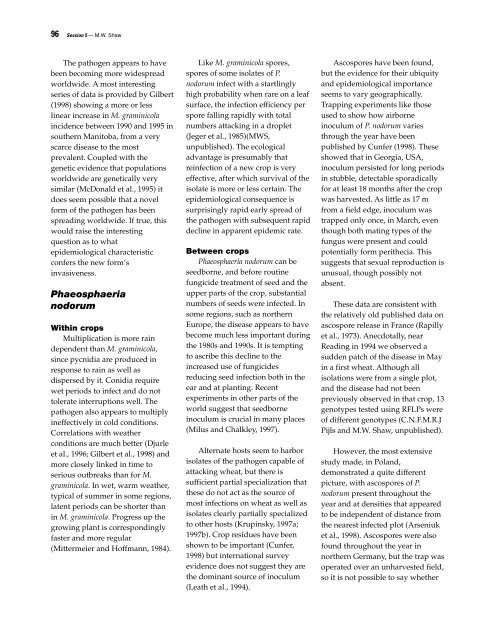Septoria and Stagonospora Diseases of Cereals - CIMMYT ...
Septoria and Stagonospora Diseases of Cereals - CIMMYT ...
Septoria and Stagonospora Diseases of Cereals - CIMMYT ...
You also want an ePaper? Increase the reach of your titles
YUMPU automatically turns print PDFs into web optimized ePapers that Google loves.
96<br />
Session 5 — M.W. Shaw<br />
The pathogen appears to have<br />
been becoming more widespread<br />
worldwide. A most interesting<br />
series <strong>of</strong> data is provided by Gilbert<br />
(1998) showing a more or less<br />
linear increase in M. graminicola<br />
incidence between 1990 <strong>and</strong> 1995 in<br />
southern Manitoba, from a very<br />
scarce disease to the most<br />
prevalent. Coupled with the<br />
genetic evidence that populations<br />
worldwide are genetically very<br />
similar (McDonald et al., 1995) it<br />
does seem possible that a novel<br />
form <strong>of</strong> the pathogen has been<br />
spreading worldwide. If true, this<br />
would raise the interesting<br />
question as to what<br />
epidemiological characteristic<br />
confers the new form’s<br />
invasiveness.<br />
Phaeosphaeria<br />
nodorum<br />
Within crops<br />
Multiplication is more rain<br />
dependent than M. graminicola,<br />
since pycnidia are produced in<br />
response to rain as well as<br />
dispersed by it. Conidia require<br />
wet periods to infect <strong>and</strong> do not<br />
tolerate interruptions well. The<br />
pathogen also appears to multiply<br />
ineffectively in cold conditions.<br />
Correlations with weather<br />
conditions are much better (Djurle<br />
et al., 1996; Gilbert et al., 1998) <strong>and</strong><br />
more closely linked in time to<br />
serious outbreaks than for M.<br />
graminicola. In wet, warm weather,<br />
typical <strong>of</strong> summer in some regions,<br />
latent periods can be shorter than<br />
in M. graminicola. Progress up the<br />
growing plant is correspondingly<br />
faster <strong>and</strong> more regular<br />
(Mittermeier <strong>and</strong> H<strong>of</strong>fmann, 1984).<br />
Like M. graminicola spores,<br />
spores <strong>of</strong> some isolates <strong>of</strong> P.<br />
nodorum infect with a startlingly<br />
high probability when rare on a leaf<br />
surface, the infection efficiency per<br />
spore falling rapidly with total<br />
numbers attacking in a droplet<br />
(Jeger et al., 1985)(MWS,<br />
unpublished). The ecological<br />
advantage is presumably that<br />
reinfection <strong>of</strong> a new crop is very<br />
effective, after which survival <strong>of</strong> the<br />
isolate is more or less certain. The<br />
epidemiological consequence is<br />
surprisingly rapid early spread <strong>of</strong><br />
the pathogen with subsequent rapid<br />
decline in apparent epidemic rate.<br />
Between crops<br />
Phaeosphaeria nodorum can be<br />
seedborne, <strong>and</strong> before routine<br />
fungicide treatment <strong>of</strong> seed <strong>and</strong> the<br />
upper parts <strong>of</strong> the crop, substantial<br />
numbers <strong>of</strong> seeds were infected. In<br />
some regions, such as northern<br />
Europe, the disease appears to have<br />
become much less important during<br />
the 1980s <strong>and</strong> 1990s. It is tempting<br />
to ascribe this decline to the<br />
increased use <strong>of</strong> fungicides<br />
reducing seed infection both in the<br />
ear <strong>and</strong> at planting. Recent<br />
experiments in other parts <strong>of</strong> the<br />
world suggest that seedborne<br />
inoculum is crucial in many places<br />
(Milus <strong>and</strong> Chalkley, 1997).<br />
Alternate hosts seem to harbor<br />
isolates <strong>of</strong> the pathogen capable <strong>of</strong><br />
attacking wheat, but there is<br />
sufficient partial specialization that<br />
these do not act as the source <strong>of</strong><br />
most infections on wheat as well as<br />
isolates clearly partially specialized<br />
to other hosts (Krupinsky, 1997a;<br />
1997b). Crop residues have been<br />
shown to be important (Cunfer,<br />
1998) but international survey<br />
evidence does not suggest they are<br />
the dominant source <strong>of</strong> inoculum<br />
(Leath et al., 1994).<br />
Ascospores have been found,<br />
but the evidence for their ubiquity<br />
<strong>and</strong> epidemiological importance<br />
seems to vary geographically.<br />
Trapping experiments like those<br />
used to show how airborne<br />
inoculum <strong>of</strong> P. nodorum varies<br />
through the year have been<br />
published by Cunfer (1998). These<br />
showed that in Georgia, USA,<br />
inoculum persisted for long periods<br />
in stubble, detectable sporadically<br />
for at least 18 months after the crop<br />
was harvested. As little as 17 m<br />
from a field edge, inoculum was<br />
trapped only once, in March, even<br />
though both mating types <strong>of</strong> the<br />
fungus were present <strong>and</strong> could<br />
potentially form perithecia. This<br />
suggests that sexual reproduction is<br />
unusual, though possibly not<br />
absent.<br />
These data are consistent with<br />
the relatively old published data on<br />
ascospore release in France (Rapilly<br />
et al., 1973). Anecdotally, near<br />
Reading in 1994 we observed a<br />
sudden patch <strong>of</strong> the disease in May<br />
in a first wheat. Although all<br />
isolations were from a single plot,<br />
<strong>and</strong> the disease had not been<br />
previously observed in that crop, 13<br />
genotypes tested using RFLPs were<br />
<strong>of</strong> different genotypes (C.N.F.M.R.J<br />
Pijls <strong>and</strong> M.W. Shaw, unpublished).<br />
However, the most extensive<br />
study made, in Pol<strong>and</strong>,<br />
demonstrated a quite different<br />
picture, with ascospores <strong>of</strong> P.<br />
nodorum present throughout the<br />
year <strong>and</strong> at densities that appeared<br />
to be independent <strong>of</strong> distance from<br />
the nearest infected plot (Arseniuk<br />
et al., 1998). Ascospores were also<br />
found throughout the year in<br />
northern Germany, but the trap was<br />
operated over an unharvested field,<br />
so it is not possible to say whether









